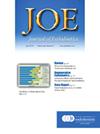四种不同牙髓密封剂浸出液随时间变化的化学、抗菌和细胞毒性特性。
IF 3.6
2区 医学
Q1 DENTISTRY, ORAL SURGERY & MEDICINE
引用次数: 0
摘要
导言:根尖牙周炎的治疗包括消灭细菌以实现根尖周围组织的愈合。为此,了解根管封闭剂长期的抗菌特性和细胞毒性非常重要。本研究旨在评估从选定的根管封闭剂中获得的浸出液的细胞相容性和抗菌活性:本研究使用了四种封闭剂:环氧树脂基封闭剂 AH Plus 和三种液压硅酸钙基封闭剂:AH Plus Bioceramic、BioRoot RCS 和 BioRoot Flow。通过扫描电子显微镜和能量色散谱分析对封闭剂的化学性质进行了评估。将密封剂圆片浸泡在 HBSS 中 28 天和 90 天,制备出测试密封剂的浸出物。使用电感耦合等离子体质谱对元素释放进行评估。将粪肠球菌和核酸镰刀菌暴露在浸出液中,然后测定其 CFU,并对人成骨细胞样细胞系 Saos-2 在浸出液刺激下的细胞死亡、caspase 表达和碱性磷酸酶活性进行评估:结果:在以硅酸三钙为基础的密封胶中检测到了钙的浸出,浸出液的 pH 值显著升高(p 结论:在以硅酸三钙为基础的密封胶中检测到了钙的浸出,浸出液的 pH 值显著升高(p 结论):受测封闭剂的浸出液具有细胞相容性,但其抗菌活性以及诱导骨形成标志物碱性磷酸酶的潜力很小。本文章由计算机程序翻译,如有差异,请以英文原文为准。
Chemical, Antibacterial, and Cytotoxic Properties of Four Different Endodontic Sealer Leachates Over Time
Introduction
The management of apical periodontitis involves the elimination of bacteria to achieve healing of the periapical tissues. To this end, understanding of the antimicrobial properties and cytotoxicity of root canal sealers over time is important. This study aimed to assess the cytocompatibility and antibacterial activity of leachates obtained from selected endodontic sealers.
Methods
Four sealers were used in this study; AH Plus, an epoxy resin-based sealer, and three hydraulic calcium silicate-based sealers: AH Plus Bioceramic, BioRoot RCS, and BioRoot Flow. Sealer chemistry was assessed by scanning electron microscopy and energy dispersive spectrum analysis. Leachates of the tested sealers were prepared by immersing sealer discs in Hank’s balanced salt solution for 28 and 90 days. Element release was assessed using inductively coupled plasma mass spectroscopy. Enterococcus faecalis and Fusobacterium nucleatum were exposed to the leachates followed by colony-forming unit determination, and the human osteoblast-like cell line Saos-2 was assessed with regard to cell death, caspase expression and activity of alkaline phosphatase (ALP) after stimulation with the leachates.
Results
Calcium leaching was detected in the tricalcium silicate-based sealers, which increased the leachate pH significantly (P < .0001). AH Plus Bioceramic leachate displayed antimicrobial activity at 28 days against E. faecalis (P < .01). ALP levels were reduced in response to AH Plus Bioceramic and BioRoot RCS 1-day leachates (P < .05). High cell viability was observed after exposure to all sealers.
Conclusions
The leachates of the tested sealers were cytocompatible; however, their antimicrobial activity as well as their potential to induce the bone formation marker ALP was minimal.
求助全文
通过发布文献求助,成功后即可免费获取论文全文。
去求助
来源期刊

Journal of endodontics
医学-牙科与口腔外科
CiteScore
8.80
自引率
9.50%
发文量
224
审稿时长
42 days
期刊介绍:
The Journal of Endodontics, the official journal of the American Association of Endodontists, publishes scientific articles, case reports and comparison studies evaluating materials and methods of pulp conservation and endodontic treatment. Endodontists and general dentists can learn about new concepts in root canal treatment and the latest advances in techniques and instrumentation in the one journal that helps them keep pace with rapid changes in this field.
 求助内容:
求助内容: 应助结果提醒方式:
应助结果提醒方式:


